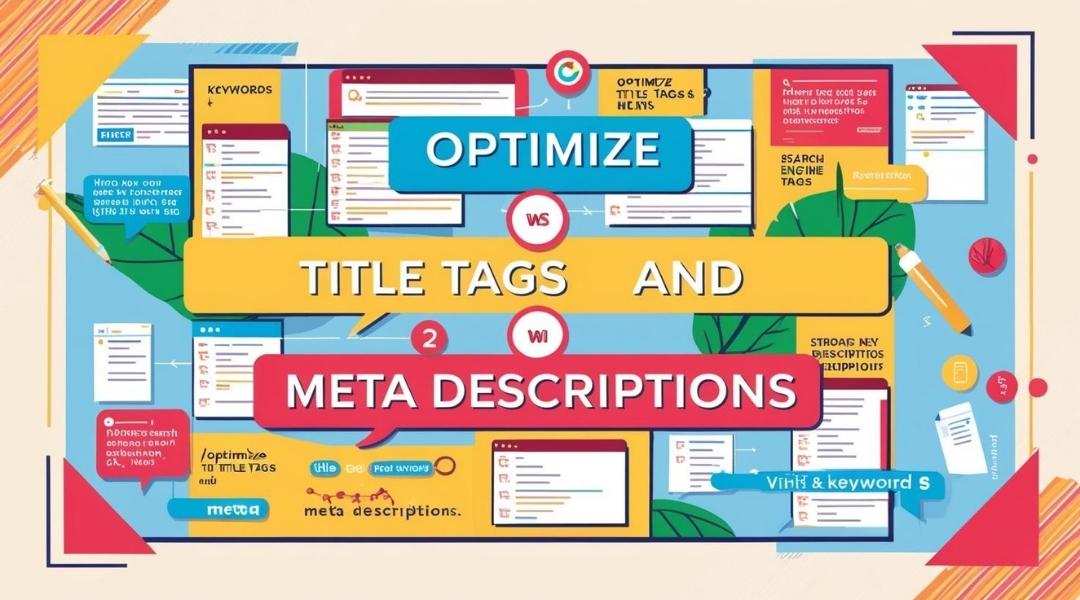Many bloggers struggle with low search engine placement. A statement from HubSpot Growth Manager Amal Kalepp shows that thoughtful keyword research reveals your competition and areas where your blog has ranking potential.
If no one is searching for your topic, traffic remains scarce. Is your blog ready for its close-up? Improving your blog’s position starts with these key areas: title tags and meta descriptions that grab attention, content that truly connects with readers, fast-loading pages, a mobile-friendly design, and content that answers what people are looking for online.
Easy-to-read text is key; it helps your message get across, so is adding internal links and getting rid of thin content.
Finding the perfect keywords is key to ranking higher; let’s look at how to do it.
Research Targeted Keywords for Better Rankings
Keyword research reveals your competition and helps you find a realistic spot for higher placement. According to a HubSpot manager, it pinpoints ranking opportunities and shapes your content strategy. People use search terms to locate solutions, so effective keyword targeting guides the right audience to you.
For instance, “cat paranormal detective” brings minimal traffic, so your Purranormal Detective Agency should shift focus. A broader phrase like “paranormal investigators” reaches 800 monthly searches and offers stronger visibility. You also gain fresh marketing insights, since terms with higher volume can reflect what potential readers seek.
Better words equal more traffic, which can translate into leads. Combine those refined keywords with your best content, and track performance. Focused selection boosts credibility too.
Leverage SEO writing AI to refine your blog’s keyword approach.
Optimize Title Tags and Meta Descriptions
- Title Tags Matter: You risk rewrites if your title tags lack detail, affecting 33.4% of pages. Keep them precise and under 60 characters for more clarity. Place your main keyword gently for smoother search visibility. Clear titles produce higher rankings and stronger engagement.
- Meta Descriptions Influence Clicks: Many high-ranking pages skip custom meta descriptions, but this can reduce click-through potential. You gain visibility if descriptions show readers why your content matters. Keep them unique and around 150 characters to avoid unhelpful cuts. Clear summaries drive more clicks and strengthen viewer trust.
- Improve Relevance and Consistency: Google may replace 62.78% of meta descriptions if they lack compelling details. You maintain control by accurately matching content to visitor needs. Ensure your keywords fit naturally instead of cramming them in undesired spots. Balanced optimization steadily shields your content from rewrites and improves search performance significantly.
Improve Content Relevance and Keyword Usage
Target relevant phrases that reflect user searches. You increase relevance when your content aligns with questions and interests. Avoid short words like “auto repair” that attract competing pages.
Instead, use phrases with three to five words that fit local or niche needs. For instance, “Best pizza in New York City.” Leading tools such as Google Keyword Planner and SEO GPT: Keyword Optimization help refine your choices. Check how many results appear for each term to gauge competition.
Use proven data from Google Trends to shape topics. Write content that answers user needs and stays on topic. Keep sentences direct, and avoid fluff.
Readers should find a clear focus that speaks to what they searched for. Observing this strategy can grow engagement. It raises your position on search results, which boosts your potential audience.
Fix Slow Page Speed to Boost Performance
A sluggish site drives visitors away and lowers your search rank. Faster pages encourage a smoother reader experience that boosts engagement.
- Compress images above 1MB, and choose JPEG for large visuals to reduce size. This helps pages load quicker and prevents visitors from leaving your site. Professional support keeps photos optimized, maintaining clarity and boosting speed.
- Streamline JavaScript by deleting scripts that slow performance or tax server resources. Unset code clogs resources, so refactoring can free bandwidth for quicker loading times. Skilled developers can optimize these processes, which enhances your blog’s overall ranking.
- Limit ad zones and external items that trigger extra HTTP requests per page. Fewer requests mean fewer delays, which keeps your content accessible without lags. Consider minimal ads to maintain monetization and ensure a pleasant user experience.
Ensure Mobile Responsiveness Across All Devices
Ensure your layout looks great on every screen to reduce bounce rates. More than half of searches arise from mobile users. You lose traffic if your pages break on smaller devices.
Google’s transition to a mobile-first index can affect your ranking. It drops if pages aren’t mobile-friendly. Proper spacing for links and clear calls to action help visitors.
Quick load times keep them on your site. A fast layout addresses Core Web Vitals, which boosts visibility. Local traffic depends on mobile readiness.
76% of local searches lead to a store visit within a day. Real-time SEO analytics help monitor mobile performance across your domain. Unlimited crawls and site audits uncover issues.
Fix them early to improve user satisfaction and search results. Keep your experience effective.
Eliminate Duplicate or Thin Blog Content
This section helps you remove pages that lack depth or repeat key messages. It also prevents penalties that reduce your ranking potential.
- Duplicate pages cause confusion for both readers and search engines. They can lead to keyword cannibalization and lower your visibility. They also lead to wasted crawl budget and user confusion.
- Thin content fails to engage visitors and signals low value to search engines. Google can penalize these pages algorithmically or with a manual review. Ranking systems now focus on content that benefits real visitors.
- Remove redundant pages or add fresh details to make them worthwhile. Search Console helps you carefully spot thin spots and recover swiftly. Always provide original insights that show genuine expertise. Google values pages with clear structure and helpful details that fully address user needs.
Focus on User Intent in Your Writing
You want to find out what people really seek before writing your post. Search logs show that a phrase like booking apps might point to appointment scheduling tools. Google spots these user patterns and rewards pages that offer direct responses.
Investigate existing page one results to see what’s truly ranking for your chosen phrase. Focus your text on the actual question behind that search. Ask yourself if your content matches reader expectations.
Clear answers help people and signal that you meet their needs. Short paragraphs, specific details, and straightforward explanations keep users engaged. Aim to provide fresh insights that surpass competing pages.
Consistently align your article with search data so readers and search engines trust your expertise. Track your engagement metrics to confirm you’re meeting those search demands effectively.
Use Internal Linking Strategically Within Posts
Placing internal links in your blog posts forms a clear site structure. These links boost SEO.
- Create a Hierarchy: Highlight your posts and link them in related articles. This directs more link value toward those central pages. Less vital pages can pass equity as well. That signals search engines that core pieces matter.
- Spread Link Equity: Links from older posts still keep newer pages relevant. These entries help visitors explore content with fewer clicks. Contextual anchors pass authority across your site naturally. This approach improves visibility for all linked pages.
- Assist Readers and Bots: Place links in intuitive locations for easy navigation. Clear linking helps humans and crawlers find content. They locate fresh pages without effort or confusion. This strategy benefits your rankings and improves user satisfaction.
Enhance Readability with Clear Formatting
You enhance comprehension by presenting content in small blocks. This approach prevents readers from feeling overwhelmed. Choose straightforward fonts like Arial, paired with clear, descriptive headings. Good spacing between paragraphs keeps the layout fresh and user-friendly.
Social sharing thrives when your site is visually appealing, helping you combat stagnant readership. For example, well-structured subheadings guide visitors through your points without confusion, improving navigation and on-page time.
Add relevant images, infographics, or short videos to maintain interest. Visual elements enhance content authority and support retention. Traffic reports often show longer sessions thanks to inviting, accessible designs.
Keep track of comments, shares, and bounce rates for cues on readability and audience engagement. When readers find your content easy to scan, they stay longer and invite others, boosting trust and visibility.
Consistent formatting also signals professionalism, building user confidence in your site’s credibility. Short bullet points or numbered lists break complex ideas into bite-sized pieces, making your insights easier to digest.
This clarity encourages ongoing engagement and strengthens your reputation as a reliable information source. Readers appreciate a combination of accuracy, clarity, and relevance—core pillars of content that meet Google’s E-E-A-T criteria.
Boosting your blog ranking calls for consistent effort, up-to-date SEO strategies, and a real connection with your readers. Keep your headings tidy, your meta descriptions snappy, and your content current, credible, and well-researched.
Resist stuffing keywords, but keep them well placed to maintain SEO value without sacrificing quality. Cite reputable sources when referencing data or making claims, reinforcing your authority and content transparency.
You might focus on load speed, as a sluggish site can turn visitors away. So, step back, assess what’s lacking, and fix it now. Blog success often builds quietly when you consistently cover the details.
Keep testing new approaches, track performance through analytics, and refine your strategy based on real insights. With time and thoughtful execution, your blog can rise to the top—earning trust, engagement, and lasting visibility.









